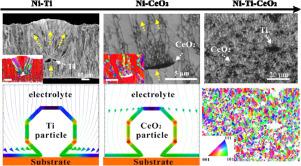Journal of Materials Science & Technology ( IF 11.2 ) Pub Date : 2021-09-01 , DOI: 10.1016/j.jmst.2021.08.002 Lianbo Wang 1 , Shilong Xing 1 , Zizhen Shen 2 , Huabing Liu 1 , Chuanhai Jiang 1 , Vincent Ji 3 , Yuantao Zhao 4

|
In current work, Ni-Ti-CeO2 nanocomposite coatings were achieved by co-adding Ti microparticles and CeO2 nanoparticles. Designed experiments and COMSOL computer simulation were applied to reveal the synergistic role of Ti microparticles and CeO2 nanoparticles in tailoring the spatial microstructures and properties of Ni-Ti-CeO2 nanocomposite coating. Unilaterally, the conductive Ti microparticles conducted the growth behavior of Ni grains by current density concentration, distorting electronic field lines and heterogeneous nucleation. Individual domains consisting of inner nanograins and outer radial columnar grains surrounded Ti microparticles, where Ti microparticles acted as seeds. Ti microparticles tended to be aggregated, leading to spatial heterogeneity of microstructures. Ni deposits buried the Ti microparticles in forms of “covering model”, contributing to the formation of inside voids and rough surface and aggregation of Ti microparticles; on the other hand, the non-conductive CeO2 microparticles hardly changed the distribution of current density and electronic field lines on the cathode surface. Ni deposits buried the CeO2 microparticle in forms of “stacking model”, avoiding the inside voids and aggregation of particles. The incorporation of CeO2 microparticle brought in microstructure evolutions only on its top side without disturbing the growth behavior of Ni grains on its lateral side or bottom, suggesting the limited effects. This was correlated with the presence of current concentration above the CeO2 microparticle at the last stage of burying CeO2 microparticle. The co-addition of Ti microparticles and CeO2 nanoparticles into Ni deposits exploited the complementary action of the two particles, which gave birth to satisfied spatial microstructures and improved hardness. Ti microparticles took major responsibility for microstructure evolutions, while the CeO2 nanoparticles were mainly in charge of the microstructure homogeneity.
中文翻译:

Ti微粒和CeO2纳米微粒在定制高质量Ni基纳米复合涂层的微观结构和性能中的协同作用
在目前的工作中,Ni-Ti-CeO 2纳米复合涂层是通过共同添加Ti 微粒和CeO 2纳米颗粒来实现的。应用设计实验和 COMSOL 计算机模拟来揭示 Ti 微粒和 CeO 2纳米颗粒在定制 Ni-Ti-CeO 2的空间微观结构和性能方面的协同作用纳米复合涂层。单方面,导电 Ti 微粒通过电流密度集中、扭曲的电子场线和异质成核来引导 Ni 晶粒的生长行为。由内部纳米颗粒和外部径向柱状颗粒组成的单个域围绕着 Ti 微粒,其中 Ti 微粒充当种子。Ti微粒倾向于聚集,导致微观结构的空间异质性。Ni沉积物以“覆盖模型”的形式掩埋Ti微粒,导致内部空隙和粗糙表面的形成以及Ti微粒的聚集;另一方面,不导电的CeO 2微粒几乎没有改变阴极表面上电流密度和电场线的分布。Ni沉积物掩埋了CeO2微粒采用“堆积模型”的形式,避免内部空隙和颗粒聚集。CeO 2微粒的掺入仅在其顶部带来微观结构演变,而不会干扰其侧面或底部的Ni晶粒的生长行为,表明效果有限。这与在掩埋CeO 2微粒的最后阶段在CeO 2微粒上方存在电流浓度相关。Ti微粒与CeO 2的共添加纳米颗粒进入 Ni 沉积物利用了两种颗粒的互补作用,从而产生了令人满意的空间微观结构并提高了硬度。Ti微粒主要负责微观结构的演变,而CeO 2纳米颗粒主要负责微观结构的均匀性。











































 京公网安备 11010802027423号
京公网安备 11010802027423号